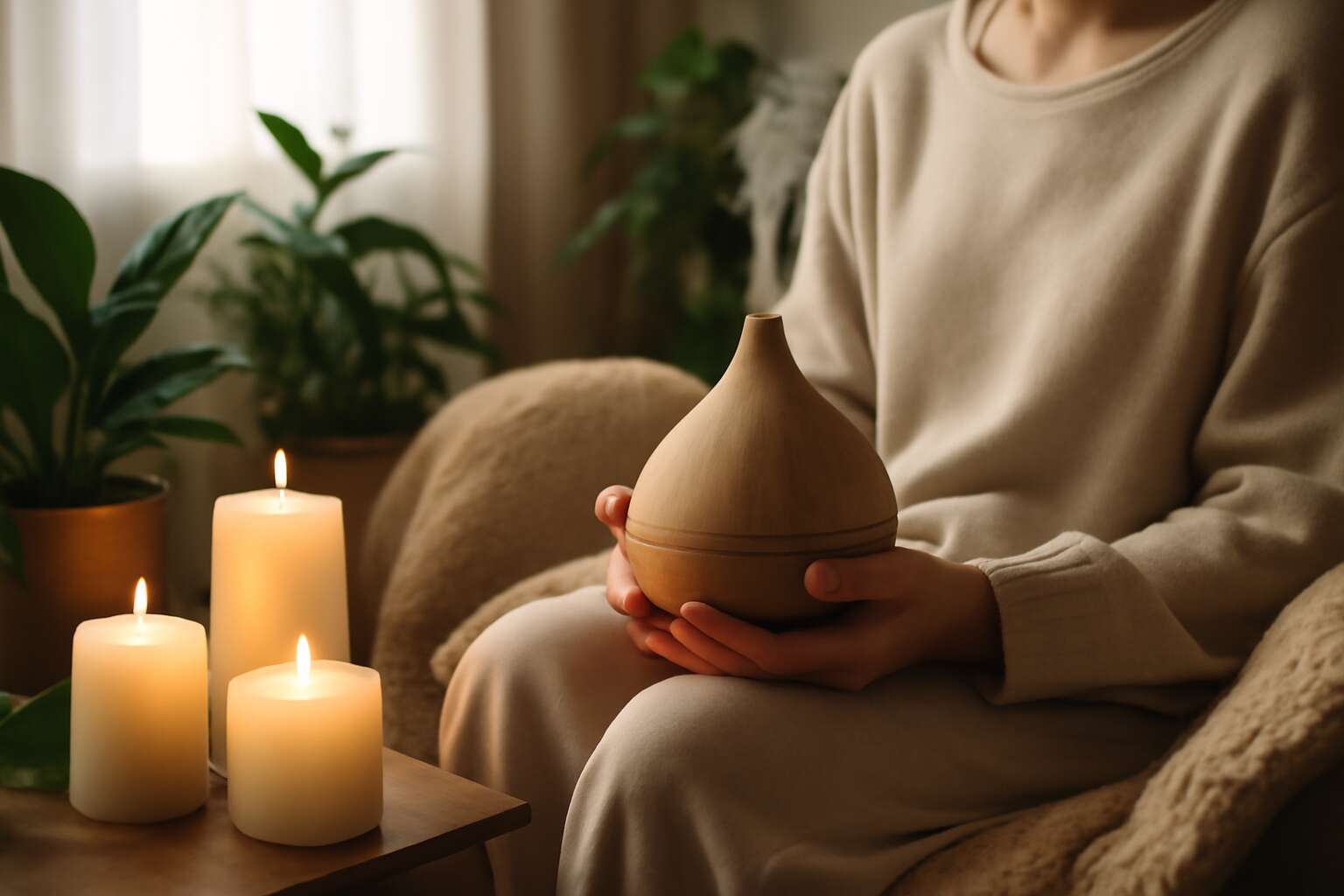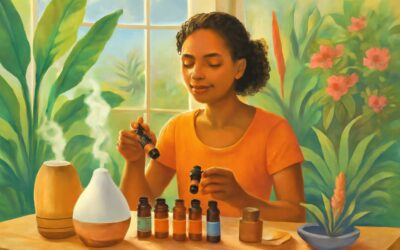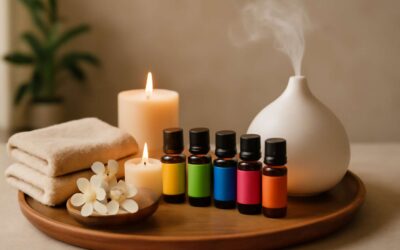Understanding Aromatherapy
What Is Aromatherapy?
Aromatherapy is an ancient art that continues to resonate deeply within our modern pursuit of well-being. It taps into the subtle power of essential oils, transforming simple plant extracts into potent tools for healing and emotional balance. When exploring aromatherapy how to use, many discover that its true magic lies in the delicate balance between scent and sensation, evoking memories, calming fears, or invigorating the spirit.
Understanding aromatherapy begins with recognizing its core premise: scent as a conduit for the mind and body. Essential oils are carefully extracted to preserve their therapeutic properties, allowing us to harness their potential in various forms—diffused, inhaled, or applied topically. The question of how to use aromatherapy effectively often leads to exploring methods such as diffusion or massage, each offering a unique pathway to harmony and vitality.
For those curious about aromatherapy how to use, an essential starting point is familiarizing oneself with the oils’ nature—some promote relaxation, while others energize. This nuanced knowledge transforms a simple practice into a profound exploration of self-awareness and subtle energy. In this dance of scent and sensation, every inhalation becomes a step toward deeper understanding and holistic healing.
Benefits of Aromatherapy
Imagine transforming your daily routine into a fragrant sanctuary—aromatherapy offers just that, a potent blend of scent and sensation that can elevate your mood and soothe your soul. The benefits of aromatherapy are as diverse as the oils themselves. From reducing stress and easing anxiety to boosting focus and energizing the body, essential oils are nature’s own pharmacy. And the best part? Learning aromatherapy how to use doesn’t require a degree in botany—just a curious nose and a sense of adventure.
Whether you prefer diffusing a calming lavender in the evening or inhaling invigorating peppermint during a sluggish afternoon, aromatherapy’s versatility shines. Some oils work wonders topically, nourishing the skin while delivering their therapeutic magic. In fact, a simple
- diffuser
- massage
- inhale
routine can turn your space into a wellness haven. When exploring aromatherapy how to use, keep in mind that each oil has its unique personality—some promote relaxation, while others spark vitality. Mastering these nuances can make your journey into aromatherapy both enlightening and delightfully fragrant.
Common Essential Oils and Their Uses
Understanding aromatherapy and its key players is essential for anyone eager to harness its full potential. Certain essential oils have become household staples because of their powerful therapeutic properties. For example, lavender is renowned for its calming effects, making it perfect for reducing stress and improving sleep quality. Peppermint, on the other hand, offers an invigorating boost of energy and can help alleviate headaches. Eucalyptus is often used to clear congestion and support respiratory health. Knowing how to incorporate these oils into your routine is what makes aromatherapy effective and enjoyable.
When exploring aromatherapy how to use, focus on the unique personality of each oil. Some are best diffused to create a soothing ambiance, while others work wonders when applied topically. For instance, tea tree oil is a natural antiseptic, ideal for skin care routines. To simplify your approach, you might start with a few staple oils and experiment with diffusing, inhaling, or applying them diluted on the skin. This flexibility is what makes aromatherapy so accessible and adaptable to every lifestyle.
- Lavender – promotes relaxation and better sleep
- Peppermint – energizes and relieves headaches
- Eucalyptus – supports respiratory health and clears congestion
Methods of Using Aromatherapy
Diffusing Essential Oils
As the gentle hum of rural life fills the air, many discover that aromatherapy how to use can transform their daily routines into moments of serenity and renewal. Diffusing essential oils remains one of the most popular methods, offering a simple yet powerful way to infuse your environment with calming or invigorating scents. Whether in a cozy living room or a tranquil bedroom, a diffuser disperses the fragrant vapors evenly, creating an oasis of peace amidst life’s hustle.
To maximize the benefits of aromatherapy how to use diffusing, consider the following approach: add a few drops of your chosen essential oil to the diffuser’s water chamber, then turn it on and breathe deeply. This method not only enhances mood but can also improve sleep and reduce stress. For those seeking a more personalized experience, using an essential oil inhaler or creating a custom scent blend can deepen your connection with aromatherapy how to use in your daily life. The possibilities are as varied as the landscapes of South Africa, each offering its own unique touch of nature’s healing touch.
Topical Application
Topical application remains one of the most intimate ways to experience the healing power of aromatherapy. When essential oils are applied directly to the skin, they bypass the respiratory system, allowing their therapeutic properties to penetrate deep into tissues. This method fosters a profound sense of connection with nature’s remedies, transforming routine self-care into a sacred ritual.
To achieve optimal results, dilute essential oils with a carrier oil such as jojoba, coconut, or sweet almond oil. A common guideline is 3-4 drops of essential oil per teaspoon of carrier oil, ensuring safety and skin comfort. Gently massage the mixture onto pulse points, along the neck, or onto areas of tension. For targeted relief, some people prefer to focus on specific zones—like the temples for headaches or the chest for respiratory support.
When considering aromatherapy how to use topically, it’s important to remember that some oils may cause sensitivities or reactions. Conducting a patch test before broader application can prevent adverse effects, especially for those with sensitive skin. With mindful practice, topical aromatherapy becomes a potent tool—an extension of daily rituals that nurtures both body and spirit, deeply rooted in the healing traditions of South Africa’s diverse landscapes.
Inhalation Techniques
In the aromatic universe of wellness, inhalation techniques are arguably the most immediate way to tap into the magic of essential oils. Unlike topical applications, which require patience and a bit of rubbing, inhaling essential oils delivers their therapeutic benefits straight to your olfactory receptors — no middlemen involved. It’s like a direct line to nature’s pharmacy, and the best part? You can do it practically anywhere!
One of the simplest methods of aromatherapy how to use for inhalation is through diffusion. Using a diffuser disperses tiny particles of essential oils into the air, creating an ambient scent that can lift your mood or sharpen your focus. Alternatively, inhaling directly from the bottle or adding a few drops to a handkerchief can provide quick relief during stressful moments. For a more immersive experience, steam inhalation—adding essential oils to hot water and breathing in the vapors—can open up congested sinuses or soothe a cough. Here’s a quick rundown of popular inhalation methods:
- Diffusers (ultrasonic, nebulizing, or heat-based)
- Direct inhalation from a personal inhaler or scent pad
- Steam inhalation with essential oils
All these techniques highlight the versatility of aromatherapy how to use, transforming simple moments into potent rituals of self-care. Whether you’re seeking clarity, calm, or a boost of energy, inhalation remains a tried-and-true method to harness the healing power of essential oils—no fancy equipment required! Just a splash of water, a few drops of your favorite oil, and a whiff of wellness. Simple, effective, and oh-so-satisfying.
Guidelines for Safe and Effective Aromatherapy Use
Choosing Quality Essential Oils
In the shadowed corridors of wellness, the subtle art of aromatherapy how to use demands a discerning eye for quality. When selecting essential oils, the difference between mere fragrance and potent elixir can be as stark as night and day. A single drop of inferior oil can sully the sacred ritual, turning serenity into a mere illusion. To truly unlock the mystic power of aromatherapy, choosing pure, high-grade essential oils is paramount. These oils are harvested from ancient botanicals, capturing the essence of their soul and potency.
Beware the allure of synthetic imitations—these imposters lack the depth and healing properties that genuine essential oils possess. When embarking on your aromatic journey, consider the origins, purity, and extraction methods of your oils. A curated list to guide your selection might include:
- Certified organic labels
- Dark glass bottles that shield the oils from light
- Transparent sourcing information from trusted suppliers
Such precautions ensure your aromatherapy how to use remains a sacred ritual, free from the taint of adulteration, allowing the true magic of nature to unveil itself in every breath and drop.
Patch Testing for Allergic Reactions
Embarking on the enchanting journey of aromatherapy how to use requires more than just passion—it demands respect for your skin and senses. Patch testing is a vital step, a gentle ritual that safeguards against allergic reactions and ensures your aromatic experience remains blissful. A simple yet profound technique involves applying a small drop of diluted essential oil on a discreet patch of skin, typically behind the ear or on the inside of the wrist, and waiting 24 hours. This silent vigil reveals whether your body welcomes the botanical gift or recoils in protest.
To deepen your understanding, consider these guidelines:
- Always dilute essential oils with a carrier oil before skin contact to minimize irritation.
- Observe for any redness, itching, or swelling—signs that the oil might not be suitable for your skin.
- If discomfort arises, wash the area with mild soap and water and discontinue use.
Remember, the sacred art of aromatherapy how to use honors both the potency of nature and the delicate balance of your body. Sensitivity varies, making patch testing an essential ritual before fully immersing yourself in the aromatic embrace of essential oils. Safety and awareness turn your aromatic journey into a harmonious dance with nature’s most fragrant secrets.
Proper Storage and Handling
In the delicate dance of aromatherapy how to use, proper storage and handling are paramount to preserving the integrity of your precious essential oils. A staggering 85% of essential oil degradation occurs due to improper storage—an alarming statistic for those seeking the purest aromatic experience. Ensuring your oils remain potent and safe requires more than just a pretty bottle; it demands vigilance and a touch of sophistication.
Store essential oils in a cool, dark place—think a cabinet away from direct sunlight and temperature fluctuations. Amber or cobalt glass bottles are your best allies, shielding the oils from harmful UV rays that can diminish their therapeutic qualities. Additionally, always tighten caps securely after use to prevent oxidation and evaporation, which can compromise their aromatic potency.
When handling essential oils, avoid exposing them to open flames or heat sources, as their volatile nature makes them highly flammable. A simple rule of thumb for safekeeping involves
- labeling each bottle clearly
- keeping them out of reach of children and pets
and maintaining a designated storage area that is both organized and respectful of the oils’ fragility. Mastering the art of proper storage and handling turns your aromatherapy journey into a safe and fragrant voyage of discovery—an essential element in understanding how to use these botanical treasures responsibly and effectively.
Aromatherapy for Different Populations
When exploring how to use aromatherapy safely and effectively, it’s vital to consider the diverse needs of different populations. Children, pregnant women, the elderly, and individuals with chronic health conditions each require tailored approaches to avoid adverse reactions. For example, some essential oils are too potent for young children and should be diluted or avoided altogether. Similarly, pregnant women must steer clear of certain oils that could stimulate uterine contractions or cause sensitivities. The key to mastering aromatherapy how to use responsibly lies in understanding these nuances.
In practice, this means adjusting dosages, application methods, and even the choice of essential oils. For sensitive groups, inhalation might be preferred over topical use, ensuring minimal skin contact. Always consult a healthcare professional when in doubt. Remember, safety isn’t just about proper storage and handling but also about respecting the unique physiology of each individual. By doing so, you ensure your aromatherapy journey remains both safe and profoundly beneficial.
Creating Personalized Aromatherapy Blends
Blending Essential Oils
Creating personalized aromatherapy blends is an art that transforms simple essential oils into a symphony of scent and sensation. When exploring aromatherapy how to use, the key lies in understanding the harmony between different oils and their unique properties. A well-crafted blend can elevate mood, ease tension, or invigorate the senses, making each experience uniquely yours.
Start by selecting essential oils that resonate with your desired effect—lavender for relaxation, eucalyptus for clarity, or citrus for an uplifting burst. To streamline your process, consider the following steps:
- Identify your goal—calm, energize, or balance.
- Choose complementary oils that work synergistically.
- Experiment with ratios, beginning with a few drops of each, and adjust to your preference.
- Test your blend by diffusing or applying it topically with proper dilution.
This meticulous approach to blending essential oils for aromatherapy how to use ensures a personalized experience that enhances well-being and captures the essence of your unique lifestyle.
Sample Recipes for Relaxation, Energy, and Focus
Creating personalized aromatherapy blends opens a door to a world of sensory delight, tailored perfectly to your mood and needs. Imagine blending calming lavender with a touch of chamomile for a tranquil retreat after a long day, or combining invigorating citrus with peppermint to spark your energy. The magic lies in understanding how to use essential oils to craft these unique concoctions. By experimenting with ratios and carefully selecting complementary oils, you transform simple ingredients into a symphony of scent that elevates your well-being.
For a relaxing aroma, try a blend with lavender, frankincense, and a hint of vanilla—diffuse it during your evening routine to unwind. Want to energize your mornings? Mix grapefruit, eucalyptus, and rosemary for a vibrant burst of vitality. Remember, the key to aromatherapy how to use effectively is to test your creations—diffuse, apply topically with proper dilution, and observe how each blend influences your mood. These personalized recipes bring the essence of nature into your daily life, making every moment a fragrant adventure.
Adjusting Blends for Personal Preferences
Creating personalized aromatherapy blends is both an art and a science. It’s about tuning into your unique preferences and adjusting your essential oil mixtures accordingly. The goal is to craft scents that resonate deeply with your mood and environment. When experimenting with aromatherapy how to use, start with small batches. Test different ratios and note how each blend affects your feelings and energy levels.
Adjusting blends for personal preferences involves a keen sense of balance. For example, if you find lavender too overpowering, dilute it further or pair it with softer floral notes. Conversely, if citrus energizes you, increase its proportion for a brighter aroma. Remember, aromatherapy how to use effectively hinges on your ability to observe your reactions and refine your blends. Incorporating a simple
- keep a journal
- record ratios
- note effects
helps turn trial-and-error into a precise art. This personalized approach ensures your scents are perfectly aligned with your wellness goals, making every session a fragrant journey tailored just for you.”
Integrating Aromatherapy into Daily Life
Home Use
Incorporating aromatherapy into daily routines transforms even the simplest moments into indulgent rituals. Imagine waking up to the gentle aroma of eucalyptus, awakening your senses and setting a positive tone for the day. Aromatherapy how to use effectively at home involves more than just diffusing essential oils; it’s about creating a sensory environment that nurtures your well-being and enhances your surroundings.
For those seeking a seamless way to embrace aromatherapy how to use, consider integrating it into your morning meditation or evening wind-down. You can add a few drops of lavender to a warm bath or sprinkle some peppermint onto your pillow for restful sleep. These small acts turn everyday tasks into moments of mindfulness and comfort. To maximize the benefits, try experimenting with different essential oils and blending techniques, allowing your personal scent profile to develop naturally.
Workplace Applications
Integrating aromatherapy into the workplace can transform the daily grind into a moment of serenity amidst the chaos. When carefully incorporated, essential oils like citrus or peppermint can invigorate and sharpen focus, helping you navigate busy mornings with clarity. Aromatherapy how to use in this setting isn’t complicated; it’s about creating a subtle sensory environment that nurtures productivity and reduces stress.
One effective approach is to use a small diffuser at your desk or in common areas, filling the air with uplifting or calming scents. For a more personalized touch, you might keep a vial of your favorite essential oil nearby, inhaling deeply during tense moments. Remember, the key to aromatherapy how to use at work lies in moderation—small doses go a long way in supporting mental alertness and emotional well-being throughout the day.
Self-Care and Spa Routines
In our increasingly hectic lives, integrating aromatherapy into daily self-care routines can be a transformative act of mindfulness. It’s a gentle reminder to pause, breathe, and reconnect with ourselves amidst the chaos. Aromatherapy how to use effectively in these routines involves simple yet intentional steps that elevate everyday moments into acts of wellness. Whether it’s a morning ritual or an evening wind-down, essential oils can serve as powerful allies in nurturing emotional balance and physical vitality.
One way to incorporate aromatherapy into self-care is through a calming diffuser session, which fills your space with soothing scents like lavender or chamomile. Alternatively, applying a diluted essential oil blend during a relaxing bath or massage can deepen your sensory experience. The key to aromatherapy how to use in this context is consistency and mindfulness—small doses of essential oils, used thoughtfully, can profoundly influence your mood and overall well-being. Remember, the goal is to create a sanctuary of serenity at home, powered by the natural potency of carefully chosen essential oils.



0 Comments